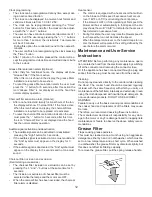
Ducting Options and Examples
Closely follow the instructions set out in this manual.
All responsibility for any eventual inconveniences, damages or fires caused by not complying with the instructions in this
manual, is declined.
Venting methods
The hood is equipped with a transition B discharge of fumes to the outside (Ducting version).
Should it not be possible to discharge cooking fumes and vapour to the outside, the hood can be used in the Ductless
(Recirculating) version. Attach a charcoal filter and the deflector F on the duct cover support bracket G. Fumes and vapours
are recycled through the top grille H by means of a duct connected to the transition B and the transtion mounted on the
deflector F.
NOTE: For the ductless (Recirculating) version only: purchase the ductless recirculating Kit.
Minimum duct size (Ducting/Ductless version): 8” Round Pipe.
Preparation
Do not cut a joist or stud if absolutely necessary. If a joist or stud must be cut, then a supporting frame must be constructed.
Fitting material is provided to secure the hood to most types of walls/ceilings.
However, a qualified technician must verify suitability of the materials in accordance with the type of wall/ceiling.
Before marking cutots, make sure there is proper clearance within the ceiling or wall for exhaust vent.
Hood installation height above cooktop is the users preferecne. The lower the hood is adove the cooktop, the more efficient
the capturing of cooking odours, grease and smoke.
CAUTION: FOR 8’ AND 9’ CEILING : MOUNT THIS HOOD SO THAT THE BOTTOM EDGE IS AT 30” (76,2 CM) MINIMUM
ABOVE THE COOKING SURFACE.
CHECK YOUR CEILING HEIGHT AND THE HOOD HEIGHT MAXIMUM BEFORE YOU SELECT YOUR HOOD.
7
Roof pitch/w
Flashing and cap
Pipe
Transition (B)
Pipe
Transition (B)
Pipe
sidewall cap
with gravity
damper
Defector (F)
Top grille (H)
Support bracket (G)
Vertical Discharge
Recirculating
Transition (B)
Summary of Contents for Hood
Page 41: ...LI3Y8A Ed 04 10 ...








































